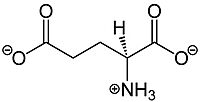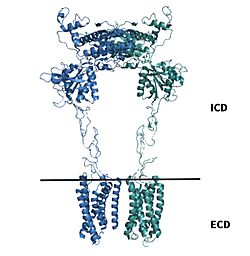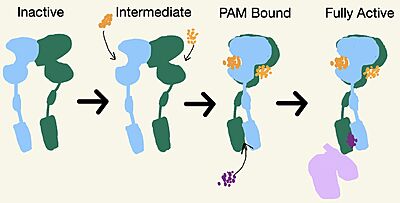Sandbox Reserved 1703
From Proteopedia
(Difference between revisions)
| (7 intermediate revisions not shown.) | |||
| Line 18: | Line 18: | ||
===Inactive State=== | ===Inactive State=== | ||
| - | A few hallmarks of the <scene name='90/904308/Inactive_structure/1'>inactive structure</scene> of mGlu2 are the <scene name='90/904307/Better_inactive_structure/3'>VFT</scene> in the open conformation, well separated <scene name='90/904307/Better_inactive_structure/2'>CRD</scene>, and distinct orientation of the 7TM. The most critical component of the inactive form is the <scene name='90/904307/Tmd_helices/9'> | + | A few hallmarks of the <scene name='90/904308/Inactive_structure/1'>inactive structure</scene> of mGlu2 are the <scene name='90/904307/Better_inactive_structure/3'>VFT</scene> in the open conformation, well separated <scene name='90/904307/Better_inactive_structure/2'>CRD</scene>, and distinct orientation of the 7TM. The most critical component of the inactive form is the <scene name='90/904307/Tmd_helices/9'>asymmetric TM3-TM4 interface</scene> formed by the 7 α-helices in the α and β chains of the 7TM. The inactive structure of mGlu2 is mediated mainly by helices 3 and 4 on both the α and β chains of the dimer through hydrophobic interactions. These <scene name='90/904307/Tm3-tm4_hydrophobic/2'>hydrophobic interactions</scene> between both transmembrane helices stabilize inactive conformation of mGlu2<ref name="Lin"/>. |
[[Image:Schematic of mGlu2.jpg|400 px|left|thumb|'''Figure 3.''' Demonstrates the conformational changes of mGlu2.]] | [[Image:Schematic of mGlu2.jpg|400 px|left|thumb|'''Figure 3.''' Demonstrates the conformational changes of mGlu2.]] | ||
===Intermediate Form=== | ===Intermediate Form=== | ||
| - | No Cryo-EM structures are currently available for the intermediate form, but it is an important state for the full activation of mGlu2. While in the intermediate form, glutamate binds the agonist binding site. The <scene name='90/904308/Agonist_binding_site/ | + | No Cryo-EM structures are currently available for the intermediate form, but it is an important state for the full activation of mGlu2. While in the intermediate form, glutamate binds the agonist binding site. The <scene name='90/904308/Agonist_binding_site/5'>agonist binding site</scene> is formed by both lobes of the VFT. To stabilize the intermediate state, one glutamate will bind, which will cause the closure of one lobe of the VFT <ref name="Seven" />. mGlu2 will still remain inactive after a glutamate is bound. The binding of glutamate promotes signaling down the receptor <ref name="Lin" />. |
===PAM and NAM Bound Form=== | ===PAM and NAM Bound Form=== | ||
| - | Moving from the intermediate state, a second glutamate will bind in the other lobe of the VFT. This will help close the VFT and move the CRD closer together <ref name="Seven" />. A positive allosteric modulator (PAM) or a negative allosteric modulator (NAM) will then come in and bind to mGlu2. PAM and NAM induce different conformational changes, which result in different outcomes. <scene name='90/904308/Pam/4'>PAM binds</scene> the TMD and promotes greater affinity for the binding of the G-protein. There are different types of PAMs that can bind to the TMD but this page focuses on JNJ-40411813<ref name="Lin"/>. PAM binds in a binding pocket that is created by helices 3, 5, 6, and 7 in the <scene name='90/904307/Tmd_helices/ | + | Moving from the intermediate state, a second glutamate will bind in the other lobe of the VFT. This will help close the VFT and move the CRD closer together <ref name="Seven" />. A positive allosteric modulator (PAM) or a negative allosteric modulator (NAM) will then come in and bind to mGlu2. PAM and NAM induce different conformational changes, which result in different outcomes. <scene name='90/904308/Pam/4'>PAM binds</scene> the TMD and promotes greater affinity for the binding of the G-protein. There are different types of PAMs that can bind to the TMD but this page focuses on JNJ-40411813<ref name="Lin"/>. PAM binds in a binding pocket that is created by helices 3, 5, 6, and 7 in the <scene name='90/904307/Tmd_helices/9'>asymmetric TM3-TM4 interface</scene> . Within helix 6, the hydrophobic binding is composed of W773, F776, L777, and F780. Due to spatial hindrance caused by the binding of PAM, helix 6 is shifted downward, causing reorientation of the TMD. This reorientation creates a cleft in the TMD for the G-protein to bind<ref name="Lin"/>. NAM, however, reduces the affinity for G protein binding. <scene name='90/904308/Nam_bound/2'>NAM binds</scene> to the same binding pocket as PAM and also interacts with residue W773, but NAM occupies the binding site a little deeper than PAM. This causes NAM to push the side chain of W773 towards helix 7, which does not form the cleft for G-protein binding<ref name="Lin"/>. |
[[Image:PAM binding pocket correct.png |300px|right|thumb|'''Figure 4.'''PAM binding pocket. PAM, JNJ-40411813, is shown in magenta and colored by atom type, four labelled binding helices (3, 5, 6, and 7) create the binding pocket in the 7TM region for PAM binding. PAM binding promotes G-protein activation by mGLu2.]] | [[Image:PAM binding pocket correct.png |300px|right|thumb|'''Figure 4.'''PAM binding pocket. PAM, JNJ-40411813, is shown in magenta and colored by atom type, four labelled binding helices (3, 5, 6, and 7) create the binding pocket in the 7TM region for PAM binding. PAM binding promotes G-protein activation by mGLu2.]] | ||
===Active State=== | ===Active State=== | ||
| - | The downward shift of helix 6, caused by PAM binding, induces a reorientation of the TMD from its original TM3-TM4 asymmetric dimer interface in the inactive form to an <scene name='90/904308/Active_7_tm_transparent/1'>asymmetric TM6-TM6 interface</scene>. The downward shift of helix 6 is crucial for the receptor’s transformation from the inactive to the active form for 2 main reasons: (1) reorientation breaks key interactions in the TMD that stabilize the inactive form and (2) repositioning <scene name='90/904308/Active_structure/ | + | The downward shift of helix 6, caused by PAM binding, induces a reorientation of the TMD from its original TM3-TM4 asymmetric dimer interface in the inactive form to an <scene name='90/904308/Active_7_tm_transparent/1'>asymmetric TM6-TM6 interface</scene>. The downward shift of helix 6 is crucial for the receptor’s transformation from the inactive to the active form for 2 main reasons: (1) reorientation breaks key interactions in the TMD that stabilize the inactive form and (2) repositioning <scene name='90/904308/Active_structure/7'>intracellular loops</scene> of in the TMD to assist in the binding and recognitions of the <scene name='90/904308/G-protein/1'>G-Protein</scene>. The G-protein is made up of three subunits: <scene name='90/904308/Alpha_subunit/1'>α-subunit</scene>, <scene name='90/904308/Beta_subunit/1'>β-subunit</scene>, and a <scene name='90/904308/Gamma_subunit/1'>γ-subunit</scene>. |
====G-Protein Recognition==== | ====G-Protein Recognition==== | ||
| - | In order for the G-protein to bind to mGlu2, so that it can be fully active, the G-protein has to be recognized by the receptor. Transition to the active state also reorients helix 3 in both monomers to enable binding to the G-protein; Yet only one chain is required for full receptor activation. The intracellular region of helix 3 contributes the main interactions with the α-subunit of the G-protein. Intracellular Loop 2(ICL2) also builds a polar interaction network with the G-protein through its ionic interactions with the <scene name='90/904308/ | + | In order for the G-protein to bind to mGlu2, so that it can be fully active, the G-protein has to be recognized by the receptor. Transition to the active state also reorients helix 3 in both monomers to enable binding to the G-protein; Yet only one chain is required for full receptor activation. The intracellular region of helix 3 contributes the main interactions with the α-subunit of the G-protein. Intracellular Loop 2(ICL2) also builds a polar interaction network with the G-protein through its ionic interactions with the <scene name='90/904308/Active_structure/6'>α-subunit</scene> of the G-protein. The ionic interactions formed further destabilize the inactive conformation so that the G-protein can be recognized and mGlu2 becomes fully active<ref name="Lin"/>. |
====G-protein Binding==== | ====G-protein Binding==== | ||
| - | The PAM induced downward shift of helix 6 coupled with the reorientation of the transmembrane domain to a TM6-TM6 asymmetric interface, opens up a cleft on the intracellular surface of the receptor. This cleft allows a <scene name='90/904308/Hook_region/ | + | The PAM induced downward shift of helix 6 coupled with the reorientation of the transmembrane domain to a TM6-TM6 asymmetric interface, opens up a cleft on the intracellular surface of the receptor. This cleft allows a <scene name='90/904308/Hook_region/2'>hook-like region</scene>, from terminal 4 residues of the α-subunit of the G-protein to move in adjacent to helix 4 in the TMD. Within this interaction, <scene name='90/904308/Hook_region_recognition/2'>C351</scene> on the hook participates in hydrophobic interactions with ICL2 and helix 4. These interactions allow the C-terminal region of the G-protein α-subunit to bind in the cleft formed by ICL2 and residues on helix 4<ref name="Lin" />.The receptor is now <scene name='90/904307/Main_active_image/4'>fully active</scene> with the dimer coupled only to one G-protein. The VFT is in the closed conformation and the TMD helices are also reoriented in both monomers to form an asymmetric dimer interface. These interactions allow the G-protein to bind which causes mGlu2 to be fully active. Now that mGlu2 is active it can regulate different signaling transductions in the cell<ref name="Lin"/>. |
==Clinical Relevance== | ==Clinical Relevance== | ||
| Line 48: | Line 48: | ||
[[7mtq]], mGlu2 inactive <br /> | [[7mtq]], mGlu2 inactive <br /> | ||
[[7mtr]], mGlu2 PAM bound <br /> | [[7mtr]], mGlu2 PAM bound <br /> | ||
| + | [[7epe]], mGlu2 NAM bound <br /> | ||
[[7mts]], mGlu2 active <br /> | [[7mts]], mGlu2 active <br /> | ||
Current revision
Contents |
Metabotropic Glutamate Receptor 2
| |||||||||||
3D Structures
7mtq, mGlu2 inactive
7mtr, mGlu2 PAM bound
7epe, mGlu2 NAM bound
7mts, mGlu2 active
References
- ↑ 1.00 1.01 1.02 1.03 1.04 1.05 1.06 1.07 1.08 1.09 1.10 1.11 1.12 1.13 Lin S, Han S, Cai X, Tan Q, Zhou K, Wang D, Wang X, Du J, Yi C, Chu X, Dai A, Zhou Y, Chen Y, Zhou Y, Liu H, Liu J, Yang D, Wang MW, Zhao Q, Wu B. Structures of Gi-bound metabotropic glutamate receptors mGlu2 and mGlu4. Nature. 2021 Jun;594(7864):583-588. doi: 10.1038/s41586-021-03495-2. Epub 2021, Jun 16. PMID:34135510 doi:http://dx.doi.org/10.1038/s41586-021-03495-2
- ↑ 2.0 2.1 2.2 Seven, Alpay B., et al. “G-Protein Activation by a Metabotropic Glutamate Receptor.” Nature News, Nature Publishing Group, 30 June 2021, https://www.nature.com/articles/s1586-021-03680-3
- ↑ Du, Juan, et al. “Structures of Human mglu2 and mglu7 Homo- and Heterodimers.” Nature News, Nature Publishing Group, 16 June 2021, https://www.nature.com/articles/s41586-021-03641-w.>
- ↑ 4.0 4.1 “Metabotropic Glutamate Receptor.” Wikipedia, Wikimedia Foundation, 27 Mar. 2022, https://en.wikipedia.org/wiki/Metabotropic_glutamate_receptor
- ↑ 5.0 5.1 \“Schizophrenia.” National Institute of Mental Health, U.S. Department of Health and Human Services, https://www.nimh.nih.gov/health/topics/schizophrenia
- ↑ 6.0 6.1 Ellaithy A, Younkin J, Gonzalez-Maeso J, Logothetis DE. Positive allosteric modulators of metabotropic glutamate 2 receptors in schizophrenia treatment. Trends Neurosci. 2015 Aug;38(8):506-16. doi: 10.1016/j.tins.2015.06.002. Epub, 2015 Jul 4. PMID:26148747 doi:http://dx.doi.org/10.1016/j.tins.2015.06.002
- ↑ 7.0 7.1 7.2 7.3 Muguruza C, Meana JJ, Callado LF. Group II Metabotropic Glutamate Receptors as Targets for Novel Antipsychotic Drugs. Front Pharmacol. 2016 May 20;7:130. doi: 10.3389/fphar.2016.00130. eCollection, 2016. PMID:27242534 doi:http://dx.doi.org/10.3389/fphar.2016.00130
Student Contributors
Frannie Brewer Ashley Wilkinson




